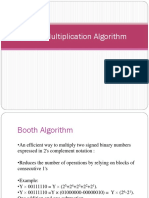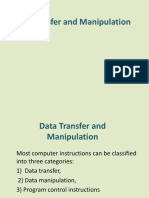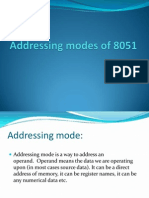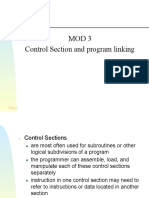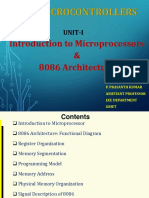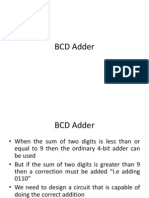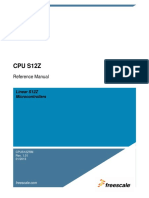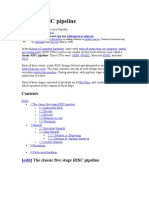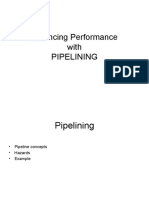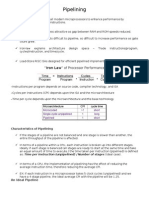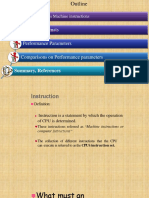Addressing Modes
Computer System Architecture
By
M. Morris Mano
Prof. S.Meenatchi, SITE, VIT
�Addressing Modes
Specify the way the operands are selected during program
execution.
Usage
To give programming flexibility to the user
pointers to memory, counters for loop control, indexing of data, .
To reduce the number of bits in the addressing field of the
inst.
Prof. S.Meenatchi, SITE, VIT
�Operation cycle of the computer
Instruction Cycle- 3 phases
1) Fetch the inst. from memory.
2) Decode the inst. (determine the operation, addressing mode and
location of the operands)
3) Execute the inst.
Program Counter (PC)
Keeps track of the insts. in the program stored in memory.
Holds the address of the inst. to be executed next.
Incremented each time an inst. is fetched from memory
Prof. S.Meenatchi, SITE, VIT
�Addressing Mode of the Instruction
Some computers use
1) Distinct Binary Code
Instruction Format
2) Single Binary Code
Designates both Operation and Addressing Mode.
Prof. S.Meenatchi, SITE, VIT
�Different Types of addressing mode
1.
2.
3.
4.
5.
6.
7.
Implied Addressing Mode
Immediate Addressing Mode
Direct Addressing Mode
Indirect Addressing Mode
Register Direct Addressing Mode
Register Indirect Addressing Mode
Displacement Addressing Mode (combines the direct
addressing and register addressing modes)
1.
2.
3.
8.
Relative Addressing Mode
Indexed Addressing Mode
Base Addressing Mode
Auto Increment and Auto Decrement Addressing Mode
Prof. S.Meenatchi, SITE, VIT
�1. Implied Mode
Operands are specified implicitly in the instruction.
No address field is required
0-address inst. are implied mode inst.
Used by Stack-organized computer
Examples:
COM : Complement Accumulator
Operand in AC is implied in the inst.
ADD
Operands are implied to be on top of the stack.
Effective Address (EA) = AC or Stack[SP]
Prof. S.Meenatchi, SITE, VIT
�2. Immediate Mode
Operand is specified in the inst. Itself.
Operand field contains the actual operand.
Useful for initializing registers to a constant value.
Advantage: No memory Reference, fast
Disadvantage: Limited operand magnitude
Example:
Instruction
LD #NBR
Opcode
Operand
Mov R1, #200
Prof. S.Meenatchi, SITE, VIT
�3. Register Mode
Operands are in registers.
Register is selected from a register field in the inst.
k-bit register field can specify any one of 2k registers.
Advantage: No memory reference, shorter instructions, faster
instruction fetch, very fast execution
Disadvantage: Limited address space as limited number of
registers
Example:
LOAD R1
MOV R1,R2
Prof. S.Meenatchi, SITE, VIT
�4. Register Indirect Mode
Register contains the address of the operand.
Advantage: address field of the inst. uses fewer bits to select a
register than bits required to select a memory address
Disadvantage: Extra memory reference
Example:
LOAD (R1)
MOV R1,(R2)
Prof. S.Meenatchi, SITE, VIT
�5. Autoincrement or Autodecrement
Mode
Similar to the register indirect mode except that
the register is incremented after its value is used to access memory
the register is decrement before its value is used to access memory
Example (Autoincrement):
LOAD (R1)+
2 forms post and pre:
Mov R1,(R2)+ post increment
Mov R1,+(R2) pre increment
Mov R1,(R2)- post decrement
Mov R1,-(R2) post decrement
Prof. S.Meenatchi, SITE, VIT
�6. Direct Addressing Mode
Operand resides in memory and its address is given in the inst.
In a branch-type inst. address field specifies the actual branch
address.
Advantage: Simple memory reference to access data, no
additional calculations to work out effective address
Disadvantage: Limited address space
Example:
LOAD ADR
MOV R1,2000
Prof. S.Meenatchi, SITE, VIT
�7. Indirect Addressing Mode
Address field of inst. gives the address where the effective
address is stored in memory
Advantage: Large address space, may be nested, multilevel or
cascaded
Disadvantage: Multiple memory accesses to find the operand,
hence slower
Example:
LOAD @ADR
MOV R1,(2000)
Prof. S.Meenatchi, SITE, VIT
�8. Displacement Addressing Mode
EA = A + (R)
Address field holds two values
A = Base value
R = register that holds displacement
Or vice-versa
Prof. S.Meenatchi, SITE, VIT
�(i) Relative Addressing Mode
PC is added to the address part of the instruction to obtain the
effective address
EA= [PC] + address part of the inst.
Advantage: Flexibility
Disadvantage: Complexity
Example:
LOAD $ADR
Prof. S.Meenatchi, SITE, VIT
�(ii) Indexed Addressing Mode
XR (Index register) is added to the address part of the
instruction to obtain the effective address
EA= [Index reg.] + address part of the inst.
Advantage: Flexibility, good for accessing arrays
Disadvantage: Complexity
Example:
LOAD ADR(XR)
Prof. S.Meenatchi, SITE, VIT
�(iii) Base Register Addressing Mode
EA=Content of a base register + address part of the inst.
Similar to the indexed addressing mode except that the register
is now called a base register (BR) instead of an index register.
Example:
LOAD ADR(BR)
Base register hold a base address
The address field of the instruction gives a displacement
relative to this base address
Prof. S.Meenatchi, SITE, VIT
�Basic addressing modes differences
Mode
Algorithm
Advantage
disadvantage
Immediate
Operand=A
Direct
EA=A
No memory
reference
Simple
Indirect
EA=(A)
Register
EA=R
Register indirect
EA=(R)
Displacement
EA=A+(R)
Large address
space
No memory
reference
Large address
space
Flexibility
Limited operand
magnitude
Limited address
space
Multiple memory
references
Limited address
space
Extra memory
refernce
Complexity
Stack
EA=top of stack
No memory
reference
Limited
applicability
Prof. S.Meenatchi, SITE, VIT
�Problems
Find the effective address and the content of AC for the given data.
Prof. S.Meenatchi, SITE, VIT
�Addressing Mode
Effective
Address
Direct Address
500
AC (500)
800
Immediate operand
201
AC 500
500
Indirect address
800
AC ((500))
300
Relative address
702
AC (PC + 500)
325
Indexed address
600
AC (XR + 500)
900
AC R1
400
Register
Content of AC
Register Indirect
400
AC (R1)
700
Autoincrement
400
AC (R1)+
700
Autodecrement
399
AC -(R1)
450
Prof. S.Meenatchi, SITE, VIT
�Numerical Example
Prof. S.Meenatchi, SITE, VIT
�Problems
A two-word instruction is stored in memory at an address
designated by the symbol W. The address field of the
instruction (stored at W + 1) is designated by the symbol Y.
The operand used during the execution of the instruction is
stored at an address symbolized by Z. An index register
contains the value X. State how Z is calculated from the other
addresses if the addressing mode of the instruction is
Direct
Indirect
Relative
Indexed
A relative mode branch type of instruction is stored in memory
at an address equivalent to decimal 750. The branch is made to
an address equivalent to decimal 500. What should be the
value of the relative address field of the instruction (in
decimal)?
Prof. S.Meenatchi, SITE, VIT
� How many times does the control unit refer to memory when it
fetches and executes an indirect addressing mode instruction if
the instruction is (a) a computational type requiring an operand
from memory; (b) a branch type.
What must the address field of an indexed addressing mode
instruction be to make it the same as a register indirect mode
instruction?
An instruction is stored at location 300 with its address field at
location 301. The address field has the value 400. A processor
register R1 contains the number 200. Evaluate the effective
address if the addressing mode of the instruction is (a) direct;
(b) immediate (c) relative (d) register indirect; (e) index with
R1 as the index register.
Prof. S.Meenatchi, SITE, VIT
� Assume that in a certain byte-addressed machine all instructions
are 32 bits long. Assume the following state of affairs for the
machine: Fill in the following table:
Address
Value
Instruction
PC
100
Load r0, #200
Immediate
R0
200
Load r0, 200
Direct
R1
300
Load r0, (200)
Indirect
100
200
Load r0,r1
Register
104
300
Load r0, [r1]
Register Indirect
108
400
Load r0, -100[r1]
Based
200
500
300
600
500
700
Load r0, 200[PC]
Addressing mode
Relative
Prof. S.Meenatchi, SITE, VIT
Value in R0
Given the following memory values and a one-address machine with an
accumulator, what values do the following instructions load into the
accumulator?
Word 20 contains 40
Word 30 contains 50
Word 40 contains 60
Word 50 contains 70
Load immediate 20
Load direct 20
Load indirect 20
Load immediate 30
Load direct 30
Load indirect 30
Let the address stored in the program counter be designated by the symbol X1.
The instruction stored in X1 has the address part (operand reference) X2. The
operand needed to execute the instruction is stored in the memory word with
address X3. An index register contains the value X4. What is the relationship
between these various quantities if the addressing mode of the instruction is (a)
direct (b) indirect (c) PC relative (d) indexed?
Prof. S.Meenatchi, SITE, VIT
� An address field in an instruction contains decimal value 14.
where is the corresponding operand located for:
Immediate addressing?
Direct addressing?
Indirect addressing?
Register addressing?
Register indirect addressing?
A PC-relative mode branch instruction is stored in memory at
address 62010. The branch is made to location 53010. The
address field in the instruction is 10 bits long. What is the
binary value in the instruction?
Prof. S.Meenatchi, SITE, VIT

